ASUS NUC14RVHv7 and ASRock Industrial NUC BOX-155H Review: Meteor Lake Brings Accelerated AI to UCFF PCs
by Ganesh T S on May 23, 2024 8:00 AM EST- Posted in
- Systems
- Intel
- Asus
- NUC
- UCFF
- Mini-PC
- ASRock Industrial
- Meteor Lake
System Performance: UL and BAPCo Benchmarks
Our 2022 Q4 update to the test suite for Windows 11-based systems carries over some of the standard benchmarks we have been using over the last several years. While UL's PCMark makes the list, we have opted to temporarily suspend reporting of BAPCo's SYSmark scores (pending fixture of the energy consumption aspect). Instead, BAPCO's CrossMark multi-platform benchmarking tool has been added to the set along with UL's Procyon suite. While CrossMark employs idle time compression and processes all workloads in an opaque manner, UL's Procyon processes real-world workloads with user interactions (like BAPCo's SYSmark). We have augmented the UL Procyon suite benchmark with our own custom energy measurement setup.
UL PCMark 10
UL's PCMark 10 evaluates computing systems for various usage scenarios (generic / essential tasks such as web browsing and starting up applications, productivity tasks such as editing spreadsheets and documents, gaming, and digital content creation). We benchmarked select PCs with the PCMark 10 Extended profile and recorded the scores for various scenarios. These scores are heavily influenced by the CPU and GPU in the system, though the RAM and storage device also play a part. The power plan was set to Balanced for all the PCs while processing the PCMark 10 benchmark. The scores for each contributing component / use-case environment are also graphed below.
| UL PCMark 10 - Performance Scores | |||

The latest and greatest from Intel usually leads the charts when the new products using them are introduced. Unfortunately, this doesn't seem to be the case with the Meteor Lake UCFF PCs. In the list above, the GTR7 has the Ryzen 7 7840HS at 65W, and it easily waltzes to the top position. However, even the Ryzen 7 7840U in the 4X4 BOX-7840U at 40W is able to surpass the Meteor Lake UCFF PCs. In fact, other than in digital content creation, none of the three Meteor Lake configurations makes a play for the top position. The reasons for this are manifold - including the available power budgets and clock speeds, which we will analyze in a later section.
UL Procyon v2.1.544
PCMark 10 utilizes open-source software such as Libre Office and GIMP to evaluate system performance. However, many of their professional benchmark customers have been requesting evaluation with commonly-used commercial software such as Microsoft Office and Adobe applications. In order to serve their needs, UL introduced the Procyon benchmark in late 2020. There are five benchmark categories currently - Office Productivity, AI Inference, Battery Life, Photo Editing, and Video Editing. AI Inference benchmarks are available only for Android devices, while the battery life benchmark is applicable to Windows devices such as notebooks and tablets. We presents results from our processing of the other three benchmarks.
| UL Procyon - Office Productivity Scores | |||
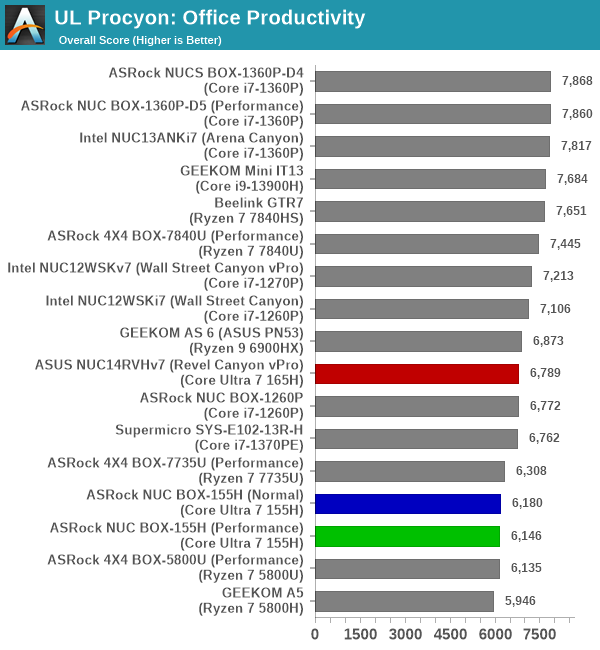
The Meteor Lake configurations perform poorly across all the office workloads, losing out to even the Wall Street Canyon NUC. It is highly likely that the Windows Thread Director is not working as intended, and tasks are ending up in the efficiency or low-power efficiency cores.
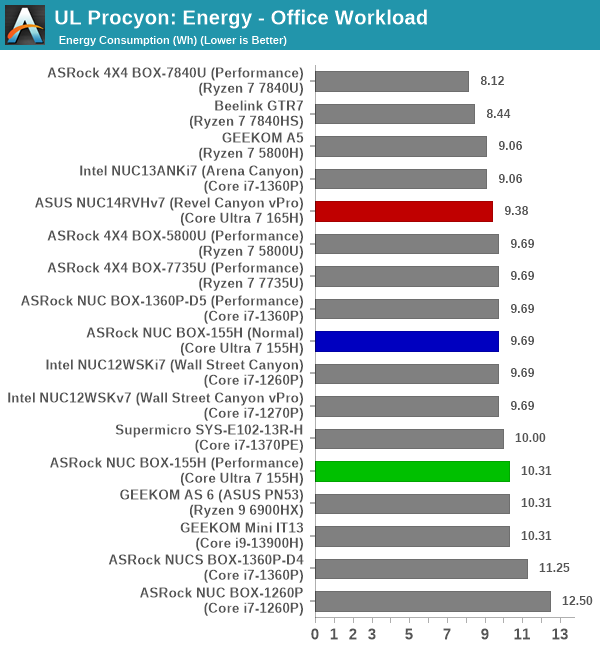
Things aren't much better from an energy consumption viewpoint either. While the absolute scores put the MTL systems in the bottom half of the comparison pack, the energy numbers see it moving slightly up. Overall, there seems to be an uptick in the power efficiency, but that isn't much to write home about when the Arena Canyon NUC ends up performing better across the board in both performance and energy efficiency metrics.
Moving on to the evaluation of Adobe Photoshop and Adobe Lightroom, we find that the NUC BOX-155H in its 40W avatar has slightly more graphics prowess compared to the NUC14RVHv7. However, the scores are still in the bottom half of the pack.
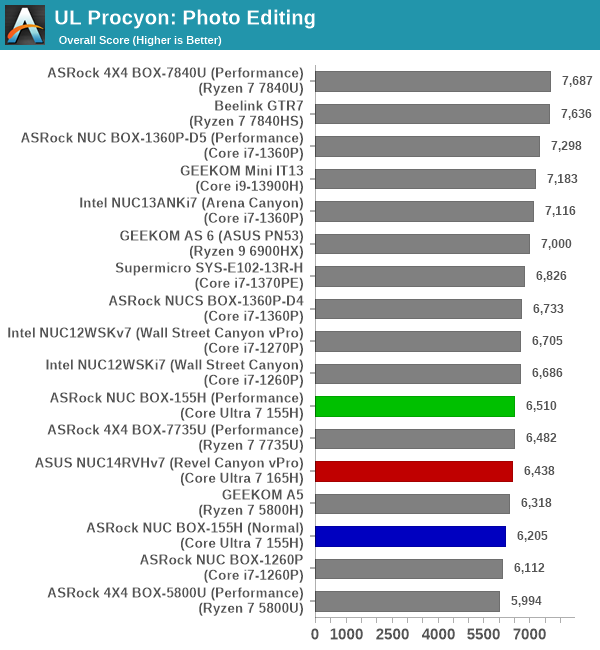
While the ASRock Industrial NUC BOX-155H in a 28W configuration gets the job done with relatively low energy consumption (still behind the latest AMD-based systems), the NUC14RVHv7 with its 64W PL1 slips to the bottom half of the pack without the performance numbers to show for it.
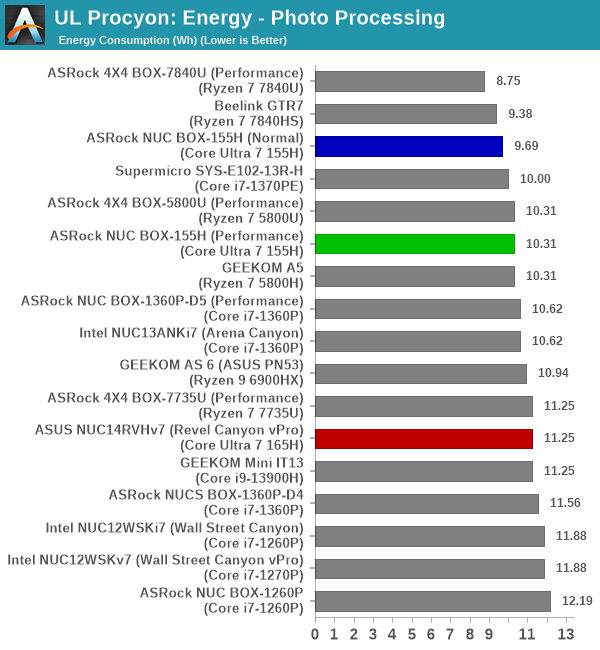
UL Procyon evaluates performance for video editing using Adobe Premier Pro.

The GPU capabilities again make a difference here, and we see the 40W NUC BOX-155H perform well enough to be in the top half of the pack. It is still behind the latest AMD systems, just like what was seen in the performance for photo processing.
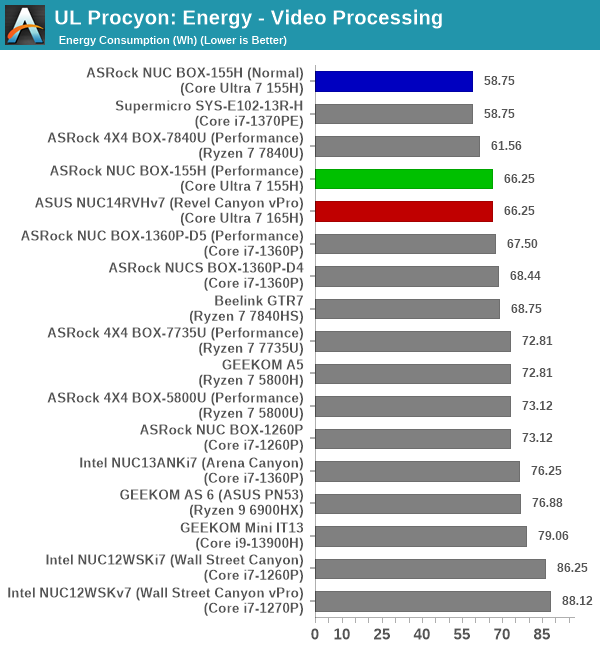
Meteor Lake finally scores a win in the energy consumption metric for this workload with the 28W configuration of the NUC BOX-155H. The chiplet architecture seems to benefit here, with even the 40W and 64W PL1 configurations making it to the top half of the pack.
BAPCo CrossMark 1.0.1.86
BAPCo's CrossMark aims to simplify benchmark processing while still delivering scores that roughly tally with SYSmark. The main advantage is the cross-platform nature of the tool - allowing it to be run on smartphones and tablets as well.
| BAPCo CrossMark 1.0.1.86 - Sub-Category Scores | |||
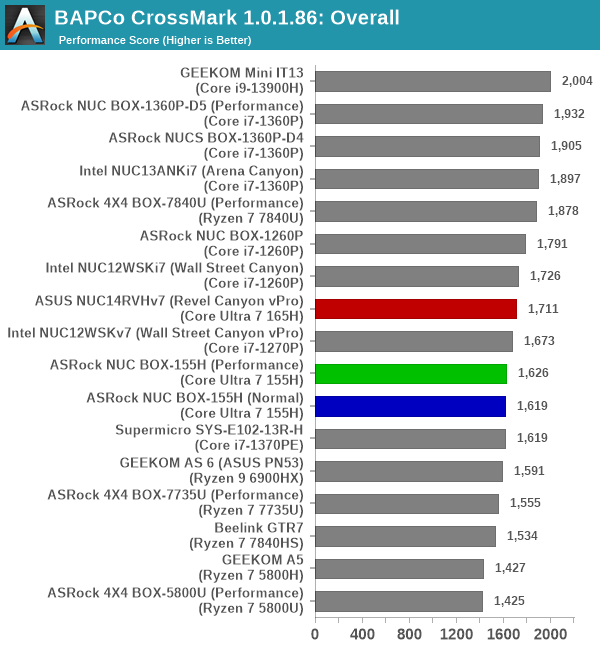
The relative performance seen in the PC Mark 10 workloads translate to CrossMark also, as expected. Things are quite dire for Meteor Lake here - even the Wall Street Canyon NUC based on Alder Lake seems to perform better than all three tested MTL-H configurations.










14 Comments
View All Comments
eastcoast_pete - Friday, May 24, 2024 - link
There are some (few) reasonably powerful mini-PCs that use a USB-C PSU; the Mercury (7840u-based) is one of them. The main advantage is, of course, that those mini-PCs can then be even more readily used with monitors that can provide USB power, meaning one less thing to carry around.But yes, PSUs with barrel connectors are cheaper (for starters, one doesn't have to pay fees to the USB Implementers Forum) . Reply
eastcoast_pete - Friday, May 24, 2024 - link
This question is somewhat OT, but I would like to know if and how the 1080p and 1440p off-screen Aztec Ruins results of the GPU benchmarks can be compared to the Aztec Ruins data for modern smartphone SoCs? I have wondered for a while just how close the performance of, for example the Adreno 750 (SD 8 Gen3) or the ARM ( Immortalis) GPU of a Dimensity 9300 come to those of a Radeon 780M or a Xe LP. ReplyPeachNCream - Tuesday, May 28, 2024 - link
Casually hitting 110 degrees under real world, non-power virus workloads must be fantastic for the health and welfare of the CPU package. Replysjkpublic@gmail.com - Tuesday, May 28, 2024 - link
Interesting. Lets throw AI in the title and try to sell a few thousand more units. I am waiting for a NUC with CAMM2. Reply